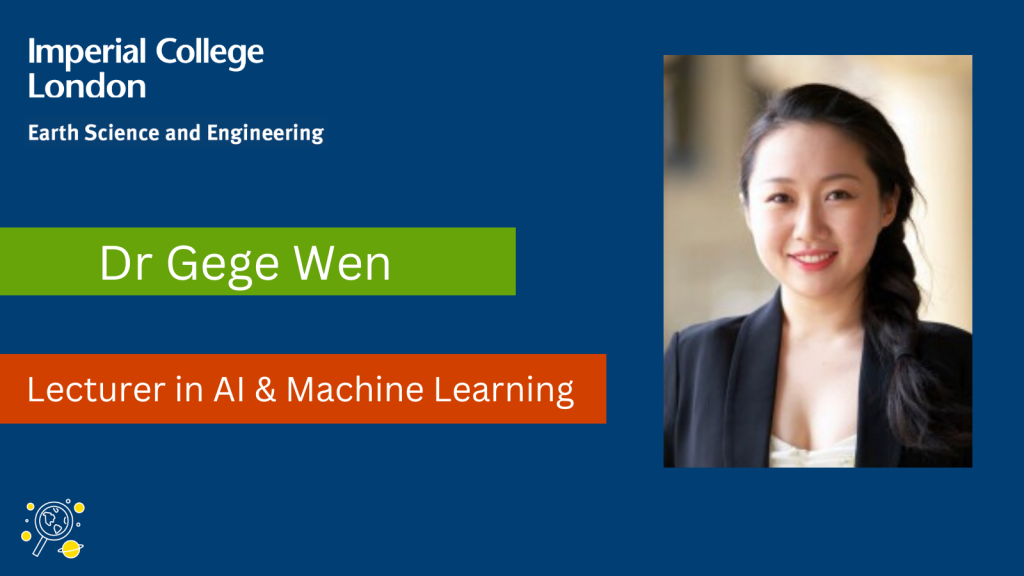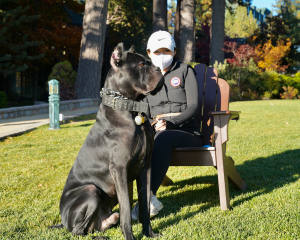
Dr Gege Wen recently joined the Department of Earth Science and Engineering (ESE) as a Lecturer in Artificial Intelligence (AI) and Machine Learning. Co-appointed by I-X, Gege’s research focuses on computational methods and solutions for Earth and environmental science problems, to help fulfil society’s energy needs and transition toward a low-carbon future.
She specialises in sustainable subsurface energy storage, CO2 geological storage, and machine learning for scientific computing. In this blog post, we explore Gege’s interests and find out more about what led her to Imperial.
Describe your work in a tweet:
I use AI to solve computational problems related to the subsurface to help accelerate the energy transition.
What drove you to your current area of work/research? Why excites you about it and why do you think it’s important?
The energy sector attracts me as it closely correlates to people’s lives. In the meantime, AI is the biggest opportunity in our generation to revolutionise the way people approach understanding the world. It is incredibly exciting to me to be able to use the great power of AI to help solve problems and bring welfare to people and all species sharing this Earth with us.
How do you see your research making an impact within and beyond academia?
I have a passion for developing tools that can help people make a better, faster, and safer transition to a low-carbon future. Luckily, in today’s world, the cycle for technology adoption is significantly shortened. An example from my previous work is that I developed a web application, CCSNet.ai, which can help CO2 storage developers quickly evaluate their projects. Releasing such a tool is a quick way for research findings to be adopted by more people.
What led you to ESE and Imperial?
This is an interesting story: two years ago, I went through a phase when I bought a lot of physical copies of books trying to fill a beautiful bookshelf my husband gifted me. I stumbled upon the “Multiphase Flow Through Porous Media” by Dr. Martin Blunt and loved it. A couple of months later, Martin came to my department to give a talk, and I immediately recognised the name on my bookshelf. We had a conversation and I became aware of the job position. I had never thought of coming to the UK before that, but I am super glad and grateful that life brought me here.
Who do you collaborate with at ESE, Imperial and elsewhere?
At ESE, I am currently collaborating with Martin Blunt, Branko Bijeljic, and Sam Krevor in CO2 storage and multiphase flow. However, as a new lecturer, I am actively looking for new areas to explore, so please contact me if you are interested in collaboration! Outside of Imperial, I’ve been working most closely with people from Caltech, Nvidia, and Stanford.
How do you embody the values of ESE (Supportive | Excellence | Integrity | Innovative | Inclusive | Inspiring) in your work?
Collaboration is key to AI research, and it is crucial to foster a supportive and inclusive environment when collaborating with others. I believe and will practice building such an environment because I believe innovation and excellent work come from creative and happy people.
What specific skills, expertise, or advice are you seeking from your colleagues at ESE?
As a new lecturer, any advice on working with students, writing grants, finding industrial partners, and navigating teaching would be very much appreciated!
What skills and expertise do you contribute to the department, and can you offer colleagues?
I am always happy to chat about the latest research/technology/ideology in AI.
What’s your favourite part of your job?
Exploring unknown territory.
What do you do to wind down?
I love to exercise when I am not working, and my new hobby is running in Hyde Park – I love to find workout buddies! I am also a plant person.
What are colleagues least likely to know about you?
My puppy is a rescue from China.
